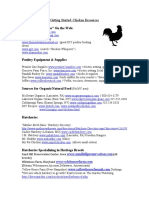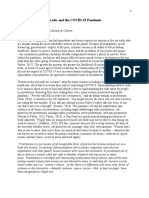Puppy Mills Research Paper Final Draft
Puppy Mills Research Paper Final Draft
Uploaded by
Amanda SchallerCopyright:
Available Formats
Puppy Mills Research Paper Final Draft
Puppy Mills Research Paper Final Draft
Uploaded by
Amanda SchallerCopyright
Available Formats
Share this document
Did you find this document useful?
Is this content inappropriate?
Copyright:
Available Formats
Puppy Mills Research Paper Final Draft
Puppy Mills Research Paper Final Draft
Uploaded by
Amanda SchallerCopyright:
Available Formats
Amanda Schaller
Puppy Mills: The Dark Hidden Secret of Animal Overpopulation
Amanda Schaller Dr. Schramm English 2 10/25/11
Amanda Schaller
Outline
I.) Introduction A.) What is a puppy mill? B.) History of puppy mills II.) Conditions of puppy mill dogs A.) Cage sizes they are kept in B.) Inadequate food and water C.) Cages not cleaned properly, left in own feces 1.) Lead to health issues 2.) Lead to emotional issues III.) Why puppy mills should be made illegal A.) Their effects on dogs as a whole B.) There effect on shelter dogs C.) Animals are abused in puppy mills IV.) The recovery of puppy mill dogs A.) Preparing for puppy mill raid B.)The trials of the owners of puppy mills 1.) Waiting for adoption 2.) Rehabilitation to trust human again a.) Dogs then getting adopted by people b.) Patience people must have when adopting a puppy mill dog V.) Conclusion A.) why puppy mills should be made illegal B.) more severe punishment for puppy mill owner and operators
Amanda Schaller
Puppy Mills: The Dark Hidden Secret of Animal Overpopulation
Animal exploitation is a growing problem in the world, with more industries deciding profits are more important than an animals welfare. In Peter Singers article Animal Liberation, he quotes Patrick Corbett to sum up how animal liberation groups feel. We require now to extend the great principles of liberty, equality, and fraternity over the lives of animals. Let animal slavery join human slavery in the graveyard of the pastqtd. (206). Animal exploitation is a growing industry with so many different areas people do not even think about or do not want to think about. There is factory farming, animals testing, and animals in circuses. There are also puppy mills, which is something I personally find truly offensive and depressing. Puppy mill dogs are a form of breeding slaves that are forced their whole lives to breed and live in small quarters. I decided to focus my research paper on puppy mills, a topic I find truly disheartening. Imagine being stuck in a hard wire cage reeking of feces and ammonia, where you could barely turn around. The wire from the cage cuts into your paws until they bleed and hurt. There is no clean water to drink and rarely any food to eat. The room is dark and damp and there are rows of other dog cages in the same condition. The only sounds you hear are dogs barking and rarely the footsteps of people coming to give you your food. No medical treatment is given when you are sick or injured. No love is given, just coldness from these humans. You are bred until you can no longer breed and then took outback and shot. This is the life of a puppy mill dog. Every eight seconds a dog in a shelter somewhere is being put to death due to overpopulation of animals and overcrowded shelters. According to the ASPCA, American Society for the Prevention of Cruelty to Animals, around 20 million dogs and cats are euthanized
Amanda Schaller
each year (3). A large part of the overpopulation problem is because puppy mills turn out thousands of dogs to be sold. Puppy mills are breeding more dogs while there are still thousands of dogs in shelters waiting to be rescued. Puppy mills treat their animals horrendously and only care about the money these animals will be making them, not about the animals themselves. According to Americas Pampered Pets, American Society for the Prevention of Cruelty to Animals (ASPCA) was founded in New York City to alleviate pain, fear and suffering in animals(19). The SPCA plays a major role in trying to rescue dogs from puppy mills. A puppy mill is a commercial dog breeding facility that is operated to sell and breed as many puppies as possible and care about profits above animal welfare. The animals are often kept in substandard conditions with no regard for their well-being. According to Wikipedia, There are an estimated 4,000 puppy mills in the U.S. that produce more than half a million puppies a year (1). Puppies that are unfortunate enough to have to be born in a puppy mill have many possible roads ahead of them. If the dogs are males, they will be sold to pet stores, other breeders, animal brokers, or directly to families if lucky. If female, they will either be sold or kept for breeding their whole lives until they no longer produce puppies, at which point they will be killed. These dogs will never know the tender touch of a loving human or what it is like to be loved. They will only know the dark and depressing life they are dealt. The cages the dogs are kept in are wire cages with wire bottoms, so standing on them hurts and cuts the dogs feet. The cages are small in size with barely enough room to turn around in depending on the dogs size and how many dogs are in the cage. The caged dogs are often kept in basements, garages or outside in sheds, so the temperatures can go from freezing cold to blistering hot depending on the time of day and season. The rooms are almost always kept dark so the animals cannot see very
Amanda Schaller
well. The rooms smell of urine and feces. These dogs live horrible lives that affect them in various ways. The affects can lead to depression and other odd behavior in the animals, and there have been instances where dogs have tried to chew their way through the metal to get out of the cage and also some dogs that will just spin in circles trying to find ways out. Puppy mills have been around for about seventy years now. They started popping up right after World War II, when farmers were seeking other ways to make money. This concept leads to the development of commercial puppy farms. Then with the increase in puppy supply, the pet retail outlets grew and big retail stores started adding pet departments to their stores. This is when pet departments and pet retail stores were created and have thrived ever since. However, since many farmers didnt know how to properly cage or care for their dogs, this often lead to poor quality. The farmers often kept the dogs in cages they already had for chickens which prohibited socialization. They did not give proper veterinary care to their dogs. Around this time, some organizations such as the Humane Society of the United States (HSUS) began investigating these puppy farms and gave them the name of puppy mills. These organizations started the efforts to make puppy mills better regulated, which is something we are still trying to do today.
Cages the dogs are kept in Dogs in puppy mills are kept in inadequate sized cages. Depending on the size of the dogs, they are either kept in a cage by themselves for the larger dog breeds or two or more in a
Amanda Schaller
cage for smaller dog breeds. According to the United States Department of Agriculture (USDA), the cage size for a dog in a puppy mill is the dogs length excluding the tail in inches, add six inches, then square that number to get the square inches of floor space; to convert to feet you would need to divide that number by 144, and the length plus six inches by twelve to get the feet and square feet of the cage. For example, I have a Jack Russell terrier and did this equation for her. She is twenty four inches long, so with six added that would be thirty inches, squared that is 900 square inches, which is 2 feet cage which is 6 square feet of cage space, not big at all. These are the requirement, however many puppy mill operators do not follow the guidelines and go smaller or place two dogs in a cage that size. Cages are stacked one on top of the other from floor to ceiling usually in a barn, garage or basement. The cages are not often cleaned if ever and since they are stacked and have wired floors this means that all the excrement from the higher up cages falls onto the dogs in the bottom cages. The dogs are often covered in their own feces and urine along with their cages often having feces caked onto them. These conditions lead too many health issues, including skin issues, eye and ear infections, and respiratory problems including staph infections.
A dog that never received vet care. If fortunate enough, food is given to the dogs once a day in dirty rusty bowls. When dogs share a cage with other dogs, it is a battle of who gets to the food first that gets to eat. The dogs
Amanda Schaller
are often given cheap food, not given the correct portion for their size, and not fed often enough. Since the dogs have been neglected and not given medical treatment, their teeth are often decaying, so it is sometimes hard for them to eat their food. According to the Animal Welfare Act, the dogs should be given clean fresh water every 24 hours, but this rarely happens. They often go without water for days, and the water they get is served in dingy moldy bowls.
A dog that was not given adequate food. These conditions also lead to emotional problems, and since the dogs have never experienced love or fun and never are let out of their cages except to be bred, they dont know how to react when saved from a puppy mill. They dont understand what it is like to run around and feel the grass on their feet, or know what its like to feel unconditional love a new owner will give them. Puppy mill dogs are often fearful and emotionally shut off since that is what they had to be in order to survive the treatment they received from the puppy mill. Most dogs recover from this with patience and time, but some may never fully heal from the pain and abuse they received when at the puppy mill. Puppy mills should be illegal for many reasons; one being they only help contribute to the overpopulation of animal problems and secondly because they often breed sick dogs that often end up dead or in a shelter due to the fact that the owner does not want to pay the money to have the dog brought back to health. While some states do have lemon laws, that are meant to help buyers of animals to receive their money back if the dog is determined to be sick
Amanda Schaller
or die from an illness caused by the breeder. Not all states have these laws in place, and those who do, not every consumer is aware of these laws and that they have a right to get their money back. I think the major reason or argument for closing puppy mills is because it is a form of animal abuse and neglect that we as a country should want to be made illegal. There are many groups on either side of this debate stating reasons why it is or is not ethical to allow puppy mills to operate. The Humane Society International and People for the Ethical Treatment of Animals (PETA) are among groups that are against puppy mills and all kind of animal abuse, and would like to make puppy mills illegal or at least more regulated. The Pennsylvania Federation of Dog Clubs (PFDC) and American Kennel Club (AKC) are groups against more regulation on puppy mills and are against them being made illegal. The prime argument against making puppy mills illegal or adding further regulating on them is it would cost breeders too much money to stay up to date with new regulations and would cause many breeders and possibly farmers to go out of business. While I recognize that enforcing regulations and increasing standards impact on cost, I think the dogs welfare is priority. Cost does not matter since regulation needs to be enforced on the puppy mills and the animals welfare should come prior to all of the other issues. Why do we need puppy mills? We do not is the easy answer. They negatively affect the dog population, they are a source of animal abuse, and they are run by people who only care about profits. The biggest cause and effect problem with puppy mills is the huge negative affect they have on shelter dogs that usually have a limited life since shelters are so overcrowded and regularly must put dogs down. There are dogs ranging in all ages that are in shelters, so if people specifically want a puppy, all they have to do is a little searching online or in person at different shelters and they are sure to find a puppy that fits their wants and needs. The plus of adopting a
Amanda Schaller
dog from a shelter is that they already come spayed or neutered so that will not be an additional cost to you, and there is usually a small fee of around $100- $150 that goes back into the shelter to help other dogs in need. Dogs adopted from shelters are also aware that you saved them and will give you unlimited love and affection and never forget you saved them. By adopting an animal from a shelter, it is a win-win situation. If you chose to buy an animal from a pet store that is usually supplied by a puppy mill or directly from a pet broker, it can only cause negative effects. You are helping a puppy mill gain profits, and you are often buying a puppy that was weaned too quickly and often can end up sick or with problems down the line. So, if you had a choice, why would you choose a puppy mill over a shelter? I know I wouldnt. With animal abuse being illegal in the United States under the Animal Welfare Act, it does not make logical sense that puppy mills are legal since puppy mills abuse their animals. They do this in the physical and emotional sense as well as neglect the animals. They abuse the animals in different ways, one being they do not give them adequate food and water, and they also do not give the animals adequate shelter from the elements. They often breed the females too often which is not good for their health, and they do not give any of the dogs adequate veterinary care. They often do procedures that should only be done by professional vets, such as debarking and C-sections. According to the ASPCA website, Debarking is controversial procedure in which a dog's vocal cords are severed so that he is unable to bark. In puppy mills, this procedure is often performed by smashing a puppy's vocal cords with a pipe (1). According to Their Day in Court, In July, Massachusetts became the first state to ban surgery that cuts or removes the vocal cords of dogs or cats. Under the law, violators are subject to fines and imprisonment of up to five years. Opponents of the law have argued that banning such surgery will result in more pets being abandoned or given to shelters (1). The emotional abuse and neglect is the lack of socialization that they give to the dogs, as well as the weaning and taking
Amanda Schaller
10
puppies away from their mother to early. Also, they do not show these dogs any affection, love or any emotion other than greed and anger. This hurts the animals in the long run, making them anti-social when bought and can also lead to health and behavior problems when the dogs become older. Puppy mill raids are the only way for these dogs and puppies to get rescued and have a chance of a normal life. These raids take hard work and dedication of animal welfare officers, usually with the Society for the Prevention of Cruelty to Animals (SPCA) or United States Department of Agriculture (USDA) whose job it is to check on puppy mills to see if they are following the guidelines set forth by the laws set forth by the state and the United States. According to Taking a Bite out of Animal Crime, It is important to scan every scene for the following signs of neglect, says Maddox. Does the animal have food, water and shelter? Does the animal appear healthy? Is its weight appropriate? Does its coat look healthy? What conditions is it living in?... (1). Preparing to raid a puppy mill requires a lot of work, which includes making sure your shelters have enough room to house all the dogs that will be confiscated indefinitely since the trials tend to take months to a year. Also you must make sure your search warrant is bullet proof since the defense for the owner of the puppy mill will try to throw every punch they can to get things over turned. You must log everything you saw and how they broke the Animal Cruelty Act along with any other local or state laws that may be applicable. The search warrant must then be signed by the local district attorney as well a judge for it to be enforceable and for the SPCA officers to legally seize the animals. Once both signatures were obtained, the raid could go ahead. When executing the warrant and raid depending on the state and county, there are certain procedures that must be followed. As stated in Saving Gracie, In Pennsylvania it was standard
Amanda Schaller
11
procedure for a highway patrol officer to be on hand to help execute a warrant (31). The officers and volunteers who help with the raid must also document everything since it will all be evidence in the trial. As stated in Saving Gracie, It was important to capture on film the deplorable conditions the dogs were living in, including the dirty water buckets, the lack of food, and the dogs matted hair. She also wanted to show any diseases, infections, or injuries visible on the animals. The videotape would tell the tale in court (31-32). Once the raid is complete and all the dogs are seized, they are now considered evidence in the trail against the owner of the puppy mill, which means they cannot be adopted until after the trail is over and all the appeals are up. This can take months to years at which point the dogs are in limbo staying at the shelters where the employees try to rehabilitate them and give them love, but it is not as good as a new home would be. In order to win the case against the owner of a puppy mill, the prosecution must prove that there was cruelty to the animals. This can be a hard and daunting task. If they do not succeed and the owner is found not guilty, the animals will be released back to him or her and most likely continued to be in the conditions they were in before. To prove cruelty requires the prosecution to call many witnesses to the stand that include the officer who executed the raid, some other people who were present and helped with the raid, veterinarians who helped care for the animals after the raid, along with any other witnesses that can help prove cruelty or that they think will help their case. While the trial of the puppy mill owner is going on, the shelter has a daunting task ahead of them, including giving any medical care necessary to the animals. This includes anything from as big as surgery to as small as flea medications. They also must start the rehabilitation process which includes showing the animals they can trust humans and trying to socialize the animals with each other as well as humans. This will help when it comes time for them to be adopted by
Amanda Schaller
12
loving people and families. This is a long and hard process since the animals have never known love or life outside of their cages. They dont know how to react when they are given their first bath or toy since they have never experienced this before. The younger the dog, usually the easier the transition to a different life is; however, the older dogs who have formed their habits around living in a cage often have a hard time learning a different life and trusting people. Since these animals are use to defecating anywhere and everywhere, they do not know how to defecate outside, and must be potty trained which can take a long time. They also do not know what to do with toys and how to go about playing since they never had a toy or room to play before. The dogs dont understand what solid ground is or grass since they have never felt it before. All these things must be learned by the dog in order to know how to react and behave in these situations. The employees and volunteers at the shelter must be patient and move at the pace that the dog is willing to move to be able to trust people again. They cannot force themselves on the dog because the dog may go back into their old habits. Since puppy mill dogs are often kept two or more to a cage, they eat very fast and tend to be protective of their food since they also werent fed enough. Food is a good way to start allowing the dogs to trust you. By giving them their food twice a day, they start to rely on you and realize that you will feed them. Another way is just to talk to them. When passing the pen or cage they are being housed in, make sure to stop for a minute or two to just say hi, I love you. The animals then start to become use to the sound of human voices in a friendly way. When the trial is finally over and hopefully the owners were found guilty, which means their dogs will not be returned to them and can be given up for adoption, it is important for owners to realize that they are adopting a puppy mill dog which does require special attention at first. They must adapt to their new home which is much bigger than anything they are used to
Amanda Schaller
13
and most likely filled with more humans than they are used to seeing on a daily basis. The dogs will have to be potty trained to go outside in the grass, as well as trained to walk on leash if the owner would like to take them for walks. Most puppy mill dogs will hide for the first few days or weeks they are brought home. As the dogs new parents, you must be patient and go at the dogs own pace, introducing it to new things slowly. According to the ASPACAs website, it is a good idea to have a safe room or place for the dog to go when they feel frightened. To me it is obvious that the Animal Welfare Act is not enough to stop puppy mills from abusing and neglecting their dogs. We need to do more as a country to make puppy mills illegal, or at least make the laws better to help protect the animals and give more severe punishment to the operators and owners of puppy mills. The 2008 Farm Bill has an amendment stating that puppies under the age of six months cannot be imported for the purpose of resale, which helps regulate puppies being imported from puppy mills from other countries. In 2008, Puppy Uniform Protection Statue was introduced to congress, but did not pass. The bill would have required all dogs to be exercised daily outside of their cage. It also would have closed the loopholes in the Animal Welfare Act that allows commercial breeders to not be licensed or be regulated by selling their puppies online and directly to the public. Sadly, this bill did not pass. In 2010, they renamed the bill The 2010 Puppy Uniform Protection and Safety Act, which stated almost the same thing as the prior bill. Sadly, this one did not pass either, but the votes for it were up from 2008. In 2011 they reintroduced the same act renaming it The 2011 Puppy Uniform Protection and Safety Act which is still pending and will hopefully be passed and help puppy mill dogs everywhere. Many states have tried to pass stricter laws for puppy mills including Pennsylvania. According to source watch, in Pennsylvania Governor Ed Rendell tried to start an initiative
Amanda Schaller
14
back in 2007 to rid the state of puppy mills. He signed HB 2525 puppy mill bill in 2008 which was different from the original bill, but it did change a few things. Dogs will have larger cages that cannot be stacked, twice yearly vet exams (if enforced) and perhaps some form of exercise. Flooring may not all be wire, but does not have to be solid either (3). While this is a start it is not enough to help the dogs stuck in puppy mills and still favors the owners of these operations. With 20 million dogs and cats being euthanized a year due to overcrowded shelters why do we need puppy mills? We do not; they are cruel to the animals and unnecessary since we already have so many animals waiting for loving homes. With The 2011 Puppy Uniform Protection and Safety Act still pending, if this is passed, it will be the first real step to stopping the abuse in puppy mills. No animal deserves to be stuck in a cage their entire life forced to live in their own excrement, in a dark room, and forced to breed until they no longer can, never knowing the tender love of a human. This is why we need to stop puppy mills and always adopt our animals so we do not support puppy mills. If we continue trying to pass legislation against puppy mills that make the owners life hard and cut into their profits, hopefully one day we will live in a world without puppy mills.
Amanda Schaller
15
Works Cited Bradley, Carol. Saving Gracie How One Dog Escaped the Shadowy World of American Puppy Mills. Hoboken, NJ: Wiley, 2010. Print. Cooper, Mary H. Americas Pampered Pets, Has our love affair with pets gone too far?. CQ Researcher. December 27, 1996 Volume 6, Issue 48. Web. 25 Sept. 2011. Dog Without Vet Care. Photo. Canine-Truth. Web. 25 Nov 2011. Garnett, Ronnie. Taking a Bite out of Animal Crime. Journal of Law Enforcement Technology. 2008: 35.7 Web. 25 September 2011. History of Puppy Mills. Protest Puppy Mills. Web. 23 Nov. 2011. PA Puppy Mills. Source watch. Web. 23 Nov. 2011. Persky, Anna Stolley. Their Day in Court.. Abstract. ABA Journal 96.9 (2010): Web. 25 September 2011. Puppy Mill Cages. Photo. October 22, 2010. Web. 25 Nov 2011 Puppy Mill. Wikipedia. Web. 7 Nov. 2011. Puppy Mills. ASPCA. Web. 27 Nov 2011. Puppy Mills: Definition, History, Common Locations. Pet Meds Online. Web. 23 Nov 2011. Singer, Peter. Animal Liberation. Current Issues and Enduring Questions: A Guide to Critical Thinking and Argument, with Readings. 9th ed. Eds. Sylvan Barnet and Hugo Bedau. Boston, MA: Bedford/St. Martins, 2011. 205-216. Print. Starving Dog. Photo. Canine-Truth. Web. 25 Nov 2011.
You might also like
- Food Allergies: A Complete Guide For Eating When Your Life Depends On It (A Johns Hopkins Press Health Book) - ISBN 9781421423388, 978-1421423388Document23 pagesFood Allergies: A Complete Guide For Eating When Your Life Depends On It (A Johns Hopkins Press Health Book) - ISBN 9781421423388, 978-1421423388adelindshawnu100% (17)
- Puppy Screening Questionnaire (Generic)Document6 pagesPuppy Screening Questionnaire (Generic)Lisa MannNo ratings yet
- Pet Industry PDFDocument12 pagesPet Industry PDFmail meNo ratings yet
- Udemy - The Complete Web Development Course - Learn by BuildDocument11 pagesUdemy - The Complete Web Development Course - Learn by Buildtakeme2techzone0% (1)
- Kayla Jackson: Technical SkillsDocument3 pagesKayla Jackson: Technical SkillsShubham PramanikNo ratings yet
- Biologic Markers in The Diagnosis and Assessment of Rheumatoid Arthritis - UpToDateDocument16 pagesBiologic Markers in The Diagnosis and Assessment of Rheumatoid Arthritis - UpToDateIzamar RomeroNo ratings yet
- Biperiden Drug StudyDocument2 pagesBiperiden Drug StudyFielMendoza100% (1)
- The Seven Types of DogsDocument5 pagesThe Seven Types of DogsMaría Auxiliadora Jácome OrtegaNo ratings yet
- Report For Dogs PDFDocument24 pagesReport For Dogs PDFBilal OthmanNo ratings yet
- Puppy Buyers Cheat Sheet Rev 9-29-2020 1Document3 pagesPuppy Buyers Cheat Sheet Rev 9-29-2020 1api-249414419No ratings yet
- Micro FarmsDocument3 pagesMicro FarmsAllie GeenNo ratings yet
- SC WD19 Eom3-1 Nbmnisi 2Document3 pagesSC WD19 Eom3-1 Nbmnisi 2Njabulo MnisiNo ratings yet
- Full Registration - Revised 2020Document12 pagesFull Registration - Revised 2020api-193641162No ratings yet
- Why's of Sustainability in BusinessDocument23 pagesWhy's of Sustainability in BusinessGerald Han100% (1)
- Lisa Simpson For Non Profit. What Science Can Teach You About FundraisingDocument24 pagesLisa Simpson For Non Profit. What Science Can Teach You About FundraisingDiagram_ConsultoresNo ratings yet
- ebags.comDocument16 pagesebags.comDonSatanNo ratings yet
- Top 50 Indian CompaniesDocument86 pagesTop 50 Indian Companieschilly_angel2093% (28)
- HOME-ARP Allocation PlanV7 202303090834037292Document60 pagesHOME-ARP Allocation PlanV7 202303090834037292Bria GremillionNo ratings yet
- Animalogy Dogs and Other CanidsDocument123 pagesAnimalogy Dogs and Other CanidsSachin NarayanNo ratings yet
- Bringing Louisiana Renters Home - An Evaluation of The 2006-2007 Gulf Opportunity Zone Rental Housing Restoration Program Policy Link)Document32 pagesBringing Louisiana Renters Home - An Evaluation of The 2006-2007 Gulf Opportunity Zone Rental Housing Restoration Program Policy Link)AnnieScanlanNo ratings yet
- Getting Started RESOURCESDocument2 pagesGetting Started RESOURCESAmanda AveryNo ratings yet
- Highlighted Links - Pet Industry - 4.16-5-15Document97 pagesHighlighted Links - Pet Industry - 4.16-5-15Angelo Pura100% (1)
- Poverty and Hunger Fact SheetDocument4 pagesPoverty and Hunger Fact SheetMr.DYNo ratings yet
- Michigan Marijuana Regulatory Agency Racial Equity Advisory Workgroup Final RecommendationsDocument30 pagesMichigan Marijuana Regulatory Agency Racial Equity Advisory Workgroup Final RecommendationsFergus BurnsNo ratings yet
- 2022 Greater New Orleans Jobs ReportDocument66 pages2022 Greater New Orleans Jobs ReportgnoincNo ratings yet
- Google Search TipsDocument3 pagesGoogle Search Tipslwilson2100% (1)
- Black Horse Energy Drink Buisness PlanDocument23 pagesBlack Horse Energy Drink Buisness Planharry6190% (1)
- Star-Cross Lovers From Acadie Á La LouisianeDocument84 pagesStar-Cross Lovers From Acadie Á La LouisianeJahshwa TerziuNo ratings yet
- MAPIC 2016 Retailers DirectoryDocument39 pagesMAPIC 2016 Retailers DirectoryMourvikaNo ratings yet
- Amazon ComplaintDocument110 pagesAmazon ComplaintNat Levy100% (1)
- Non Profit Organization Business Plan 2 D12020Document35 pagesNon Profit Organization Business Plan 2 D12020charles bautistaNo ratings yet
- AI Blast - CopyDocument28 pagesAI Blast - Copys3dp0t15No ratings yet
- Solutions To Practice Exercises: XML DTDDocument6 pagesSolutions To Practice Exercises: XML DTDkrutil76652No ratings yet
- Prostitution, The Sex Trade, and The COVID-19 PandemicDocument26 pagesProstitution, The Sex Trade, and The COVID-19 Pandemicmatheus de oliveiraNo ratings yet
- Know The List of Highest Paid Youtubers in IndiaDocument1 pageKnow The List of Highest Paid Youtubers in IndiaDetained EngineersNo ratings yet
- Detroit Dog Rescue Grant RequestDocument7 pagesDetroit Dog Rescue Grant RequestJoe W. ShapiroNo ratings yet
- Anonymous Message On Wikileaks & The Rise of TrumpDocument2 pagesAnonymous Message On Wikileaks & The Rise of TrumpProfessor WatchlistNo ratings yet
- Stay Smart OnlineDocument11 pagesStay Smart OnlineNazdir9No ratings yet
- Research GrantsDocument2 pagesResearch GrantsHaider Ali BhattiNo ratings yet
- 2007 Woman Owned Business ListDocument294 pages2007 Woman Owned Business ListBhupendra SinghNo ratings yet
- WpsetupDocument120 pagesWpsetuptunggal KecerNo ratings yet
- The Status of Aquaponics: 2010Document52 pagesThe Status of Aquaponics: 2010Aquaponics100% (1)
- 8 Killers Steps To Free WordPress WebsitesDocument11 pages8 Killers Steps To Free WordPress WebsitesDivya RanaNo ratings yet
- So You Want To Be A Dog Breeder. What's Next?Document27 pagesSo You Want To Be A Dog Breeder. What's Next?WeretubaNo ratings yet
- Account Generator The Order To Cash CycleDocument26 pagesAccount Generator The Order To Cash Cyclefloatingbrain100% (4)
- My Youtube Video StatsDocument31 pagesMy Youtube Video StatsVan Der KokNo ratings yet
- Lcloseouts Dec2018 PDFDocument29 pagesLcloseouts Dec2018 PDFWili MamaniNo ratings yet
- Wholesale TradeDocument15 pagesWholesale TradeReetika AnandNo ratings yet
- MealwormDocument3 pagesMealwormangeunkacang0% (1)
- Speech Recognition - Commands List Cheatsheet (Siri, Now, Alexa - Pi, Cortana - Kinect, Dragon)Document24 pagesSpeech Recognition - Commands List Cheatsheet (Siri, Now, Alexa - Pi, Cortana - Kinect, Dragon)BCmoneyNo ratings yet
- Uber (Company) - Wikipedia, The Free EncyclopediaDocument20 pagesUber (Company) - Wikipedia, The Free EncyclopediaPrashast Singh100% (1)
- Baznas Vending Machine 2024Document14 pagesBaznas Vending Machine 2024sahardi pagiNo ratings yet
- Business Plan - Marketing Plan - HempDocument12 pagesBusiness Plan - Marketing Plan - HempShahfaliqTeoNo ratings yet
- Welcome Everyone!: Tonight's LessonDocument53 pagesWelcome Everyone!: Tonight's LessonChris GoffNo ratings yet
- Passive Digital Income: You Are One Passive Digital Income Away From Achieving Financial Freedom: Entrepreneurial Series, #1From EverandPassive Digital Income: You Are One Passive Digital Income Away From Achieving Financial Freedom: Entrepreneurial Series, #1No ratings yet
- Business Ideas to Make a Million Dollars or Some Money SometimeFrom EverandBusiness Ideas to Make a Million Dollars or Some Money SometimeNo ratings yet
- What Type of Home Business Should You Start?: MFI Series1, #118From EverandWhat Type of Home Business Should You Start?: MFI Series1, #118No ratings yet
- KPCPDocument148 pagesKPCPstay312No ratings yet
- Consenso de MunichDocument10 pagesConsenso de MunichBartholomew AllenNo ratings yet
- Daftar Obat Yang Aman Bagi Ibu HamilDocument14 pagesDaftar Obat Yang Aman Bagi Ibu HamilIcha Marisa LanaNo ratings yet
- Death Obituary Ewafc PDFDocument9 pagesDeath Obituary Ewafc PDFTorres99McCallumNo ratings yet
- Git Exam 2015 PDFDocument50 pagesGit Exam 2015 PDFIbrahim BarhamNo ratings yet
- Journalism Versus LiteratureDocument2 pagesJournalism Versus LiteratureLeona100% (1)
- Pep Protocol 2016Document2 pagesPep Protocol 2016Migori ArtNo ratings yet
- Thyroid Physiology and Thyroid Function Testing: Angela M. Leung, Gregory A. BrentDocument16 pagesThyroid Physiology and Thyroid Function Testing: Angela M. Leung, Gregory A. BrentAgustinaNo ratings yet
- Anti PLA 2R - ELISADocument1 pageAnti PLA 2R - ELISAvemalNo ratings yet
- Pathogenesis of HIV-Related Lung Disease Immunity, Infection, and InflammationDocument31 pagesPathogenesis of HIV-Related Lung Disease Immunity, Infection, and InflammationAqua Rius JudarNo ratings yet
- SATO Dental Asymmetry - TMDDocument5 pagesSATO Dental Asymmetry - TMDJorge Mori VelásquezNo ratings yet
- Analgesic Activities of Geodorum Densi Orum, Diospyros Blancoi, Baccaurea Rami Ora and Trichosanthes DioicaDocument7 pagesAnalgesic Activities of Geodorum Densi Orum, Diospyros Blancoi, Baccaurea Rami Ora and Trichosanthes DioicavanbanbinhdinhNo ratings yet
- BCECE 2014 Biology Question PaperDocument11 pagesBCECE 2014 Biology Question PaperAnweshaBose67% (12)
- Chronic Illness - Diabetes and Hypertension (RRL)Document4 pagesChronic Illness - Diabetes and Hypertension (RRL)Kasangga IsaganiNo ratings yet
- Final Project FinalDocument69 pagesFinal Project FinalIonicNo ratings yet
- IV FluidsDocument6 pagesIV FluidsAr-jay PorrasNo ratings yet
- Remidial PHBDocument5 pagesRemidial PHBdewi sofiyahNo ratings yet
- Renal Replacement Therapy: Sreekumar E J Darlong VDocument62 pagesRenal Replacement Therapy: Sreekumar E J Darlong VSree KumarNo ratings yet
- SPUTUM SPECIMEN COLLECTION Course Unit - Micro-Para LabDocument3 pagesSPUTUM SPECIMEN COLLECTION Course Unit - Micro-Para LabDan Emerson GuillermoNo ratings yet
- Cell DivisionDocument10 pagesCell DivisionMEDRANO, Hana Jhiemyka O.No ratings yet
- Biology Project: Coffee AddictionDocument13 pagesBiology Project: Coffee AddictionRaghav Deshpande30% (10)
- Peds EORDocument29 pagesPeds EORAndrew BowmanNo ratings yet
- Pharmacology Midterm ReviewerDocument2 pagesPharmacology Midterm ReviewerRain AndrionNo ratings yet
- Tube Thoracostomy Chest Tube Implantation and Follow Up: Review ArticleDocument10 pagesTube Thoracostomy Chest Tube Implantation and Follow Up: Review ArticleAnasthasia hutagalungNo ratings yet
- 3 Science - 14-15 (CBCS) PDFDocument163 pages3 Science - 14-15 (CBCS) PDFRaj SharmaNo ratings yet
- BOOK - Female Body in Mind - The Interface Between The Female Body and Mental HealthDocument305 pagesBOOK - Female Body in Mind - The Interface Between The Female Body and Mental HealthSarah RücklNo ratings yet
- Bates Outline of Chapter 8Document15 pagesBates Outline of Chapter 8KatherynSotoNo ratings yet

























































































